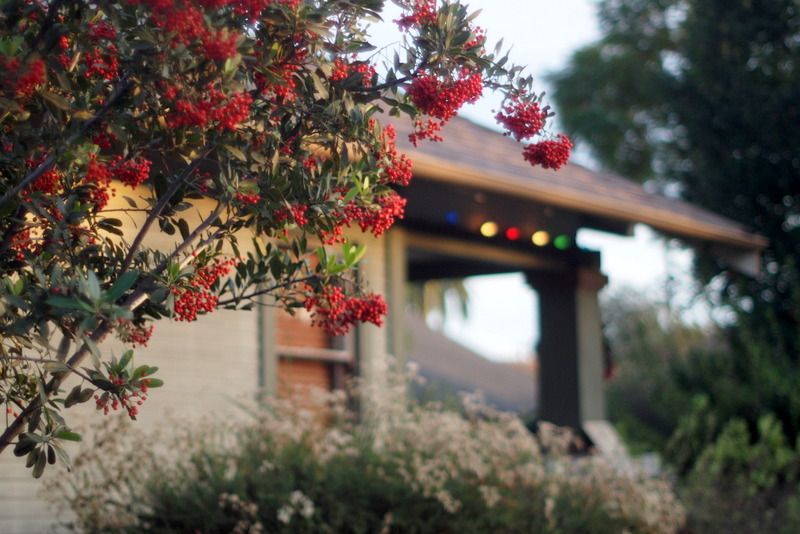
There’s an old urban legend that early European settlers in Los Angeles, where this holly lookalike grew especially abundant, named their new home in its honor.
Hollywoodland. Ultimately shortened to Hollywood.

At a neighbor’s holiday party over the weekend, I discovered it in full-on berriment growing on the west side of their bungalow.
Of course, today I just had to beg for a few sprigs of berries to bring home.
(As far as I can tell, I’ve now coined that word “berriment,” and it just might stand as my lasting contribution to humankind.)
The foamy mass in the background is a native buckwheat, but not, because I asked, the giant St. Catherine’s Lace (Eriogonum giganteum).
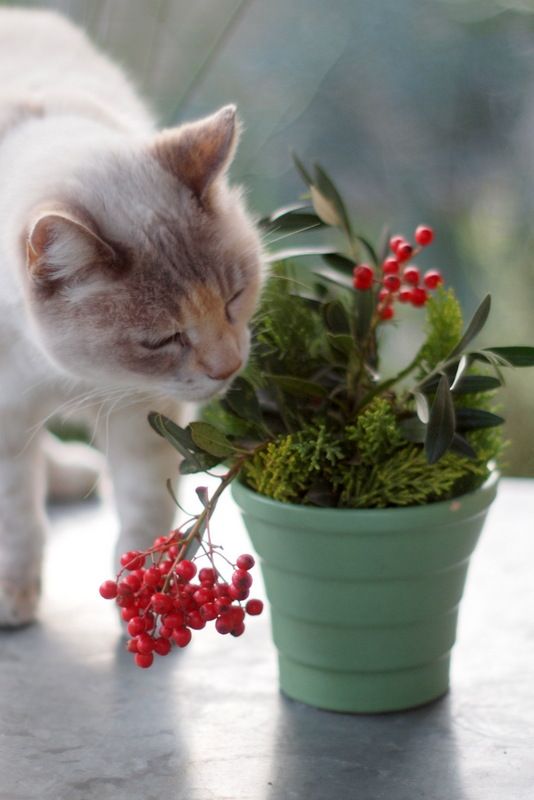
Irresistible impulses, like mine, to bring indoors the toyon’s bright red berries began to threaten its very existence until a law was passed in the 1920s prohibiting picking the berries in the wild.
A ban local birds wildly celebrated. There’s a complicated bit of science and tanins and whatnot involved in the question of toxicity to humans, but the short, safe version is don’t.
Just don’t eat the fresh berries. Notwithstanding the fact that local Indians did all manner of clever things with the flowers, berries and bark, for food and medicine.
Usual size is 8 to 15 feet, but it can and does grow bigger. My neighbor’s toyon is trained as a small tree, but it can also be grown as a hedge.
Easy and forgiving, sun or even part shade, tolerant of regular irrigation or, once established, summer drought.

Other plants in the vase are sprigs of lemon cypress and olive from our garden, very familiar to Evie, but the toyon from just a dozen houses away might as well have been from another country.
Evie immediately leapt onto the table to investigate. Bears and coyotes are known to eat the berries, but I have no idea what the digestive tract of Felis catus would make of them.

Evie never sampled, but did make a thorough, full-vase investigation.
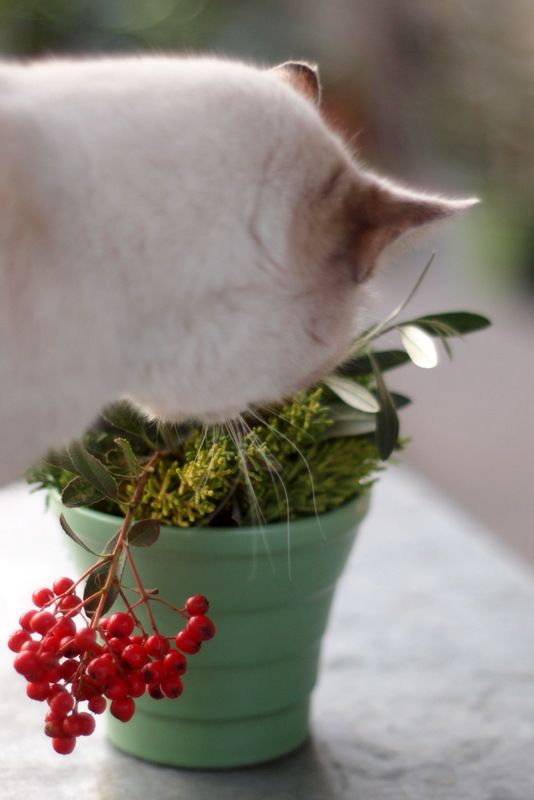
I filled a couple urns for the mantle too, mostly with lemon cypress and olive branches, with just a few sprigs of toyon berries, which manage to communicate holiday merriment even in very small quantities.
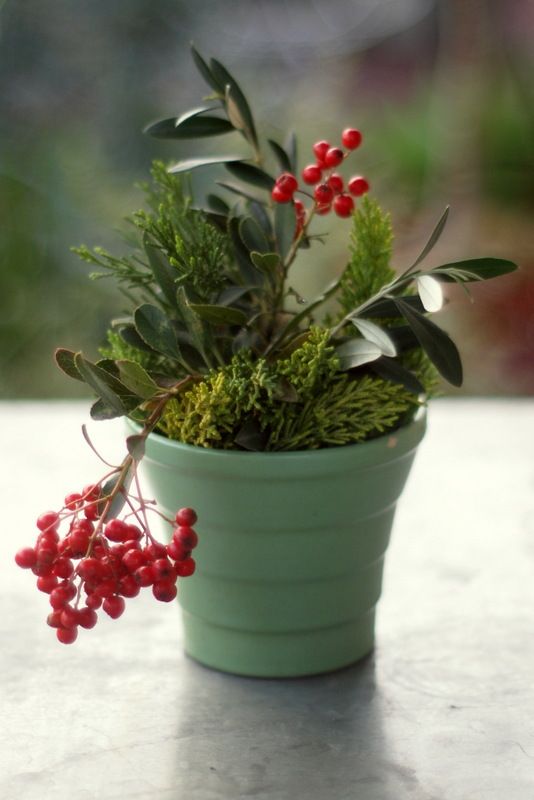
Toyon became the official native plant of Los Angeles on April 17, 2012.
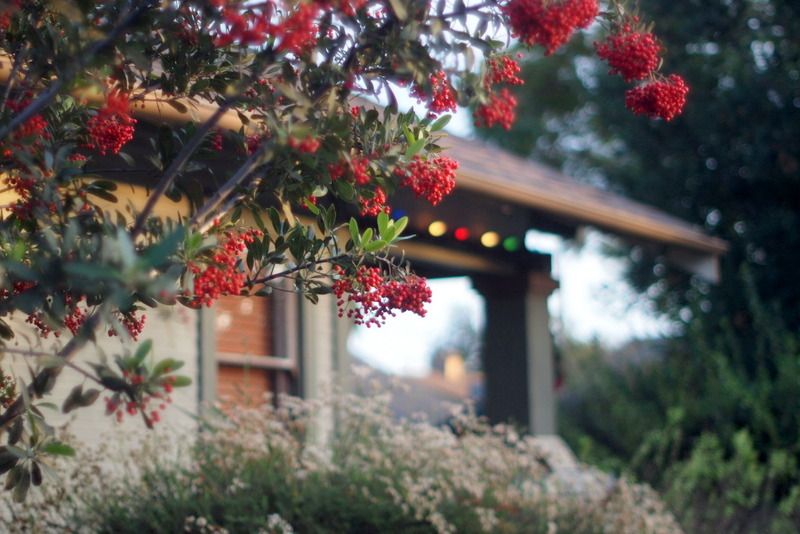
For berries of your own to bring indoors during the winter holidays as much as you please, toyon is carried in local nurseries, usually at fall planting time.
Los Pilitas Nursery is also a source, as well as the Theodore Payne Nursery and Rancho Santa Ana Botanic Garden’s Grow Native Nurseries.
Any of the above resources will patiently and knowledgeably explain how toyon can be an essential evergreen in your summer-dry garden.

Toyon grows wild in the neighborhood, and at this time of year coyote scat is easily identified because it is full of berries. The coyotes don’t seem to digest the berries–perhaps they are a purgative. A flock of cedar waxwings arrives about this time of year and strips each plant clean of its berries, one plant per day. Then the coyote scat goes back to its normal composition of mostly rodent fur.
Toyon is just as beautiful in berriment! up here, but I’ve never noticed any birds stripping the berries off shrubs, they seem to hold onto berries forever, or at least for 2~3 months. Is the golden berry form, Davis Gold seen in gardens down south? I planted one in a neighbor’s garden, but it didn’t retain berries much.
Happy berriment indeed! I’m very fond of Toyon myself and in fact cut some of the berries off the tree-sized shrub at the edge of our property to add color to our holiday wreath. I would have cut more but most are too high to reach and the tree is situated along a downward-facing slope – I risked life and limb to get the ones I did.
Lots of toyon around here as well, planted not wild. I think it looks much nicer trained as a tree instead of its native growth habit, which tends more towards a dense hedge. I really like your combination of toyon, olive and cypress!
@Hoov, the scatman! You have such an eye for detail…
@David, I’ve never seen the Davis Gold form. Sounds great in theory.
@Kris, my neighbors overhangs the sidewalk so I discreetly took a few bunches that needed pruning anyway…or so I told him!
@Gerhard, and the lemon cypress has that wonderful scent to add.
Lovely photographs =)
Spotted toyon in Greece last year, on the Peloponnese peninsula! And don’t forget our wonderful south OC nursery: Tree of Life, a wonderful destination in and of itself, with straw bale buildings, unique pots and small gift shop with local goods. There’s usually an art exhibition too. Need more exercise than just buying and browsing? Right next door is Casper’s Park with trails for hiking and mountain biking. Two hidden gems of OC, especially at this time of the year.
@Thank you, Jessica! I’m hoping to get lots of practice on the new camera in 2015
@Laura, thanks for bringing up Tree of Life, another excellent resource. And hiking just happens to be on my list of new year resolutions too.
Toyon plants make the BEST honey. It is very strong flavored and is my most favorite.